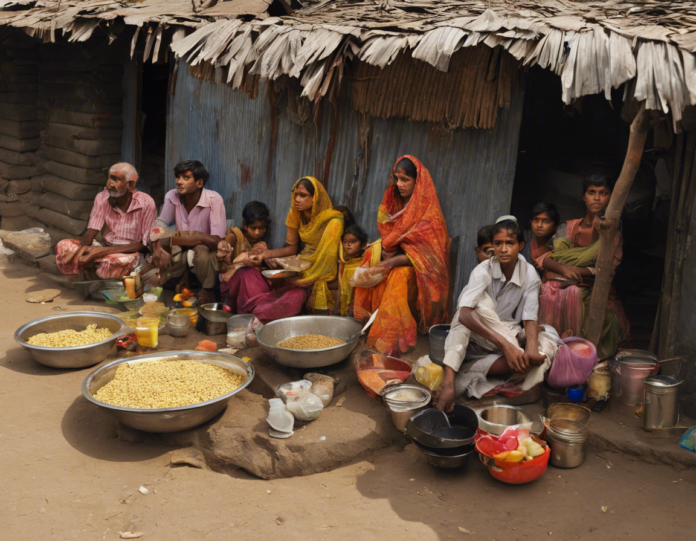Introduction
In a country as diverse and vibrant as India, the issue of food insecurity continues to persist, affecting millions of individuals and families across the nation. While India has made significant strides in various sectors, the challenge of ensuring food security for all remains a pressing concern. In this article, we will delve into the various aspects of food insecurity in India, the factors contributing to this persistent issue, and potential solutions to address it effectively.
Understanding Food Insecurity
Food insecurity, as defined by the Food and Agriculture Organization (FAO), occurs when people do not have access to sufficient, safe, and nutritious food to meet their dietary needs for an active and healthy life. This lack of access to an adequate amount of food stems from various underlying factors, including poverty, inadequate food distribution systems, lack of infrastructure, climate change, conflict, and more.
Key Factors Contributing to Food Insecurity in India
-
Poverty: One of the primary drivers of food insecurity in India is poverty. A significant portion of the population lives below the poverty line, making it challenging for them to afford nutritious food regularly.
-
Unequal Distribution: Disparities in food distribution and access further exacerbate the issue of food insecurity. While urban areas may have abundance, rural and remote regions often struggle to access an adequate food supply.
-
Climate Change: India’s agricultural sector is highly vulnerable to the impacts of climate change, including unpredictable weather patterns, droughts, floods, and natural disasters. These factors pose a threat to food production and can lead to shortages and price hikes.
-
Lack of Infrastructure: Inadequate infrastructure, such as storage facilities, transportation networks, and market access, hinders the efficient distribution of food across the country. This can result in food wastage and limited access to essential food items.
-
Government Policies: While the Indian government has implemented various food security programs and initiatives, challenges such as corruption, bureaucratic inefficiencies, and lack of proper implementation can hamper their effectiveness in reaching those most in need.
Impact of Food Insecurity
The consequences of food insecurity are far-reaching and detrimental, impacting not only individuals’ health and well-being but also the overall socio-economic development of the country. Some of the key impacts include:
- Malnutrition: Insufficient access to nutritious food can lead to malnutrition, stunting, and micronutrient deficiencies, particularly among children and pregnant women.
- Health Risks: Food insecurity is associated with an increased risk of various health conditions, including obesity, diabetes, cardiovascular diseases, and other chronic illnesses.
- Education: Lack of proper nutrition can hinder children’s cognitive development, learning abilities, and school performance, perpetuating the cycle of poverty and food insecurity.
- Economic Burden: Food insecurity not only affects individuals’ health but also imposes a significant economic burden on the healthcare system, food assistance programs, and overall productivity.
Addressing Food Insecurity in India
While the challenge of food insecurity in India is complex and multi-faceted, there are several strategies and interventions that can help alleviate the problem and promote sustainable food security:
-
Enhancing Agricultural Productivity: Investing in agriculture, promoting sustainable farming practices, providing access to modern technologies, and improving irrigation systems can boost food production and ensure a stable food supply.
-
Strengthening Food Distribution Systems: Developing robust food distribution networks, storage facilities, and transportation infrastructure can help streamline the process of delivering food from farms to markets and reducing food losses.
-
Promoting Nutrition Education: Raising awareness about the importance of a balanced diet, promoting nutrition education in schools and communities, and encouraging healthy eating habits can contribute to reducing malnutrition and improving overall health outcomes.
-
Empowering Vulnerable Groups: Implementing targeted food assistance programs, such as subsidized food schemes, mid-day meal programs for children, and maternity support initiatives, can help uplift vulnerable populations and ensure their access to adequate nutrition.
-
Policy Reforms: Strengthening governance, enhancing transparency, reducing food waste, and improving the effectiveness of food security policies and programs are essential for addressing the root causes of food insecurity in India.
Conclusion
In conclusion, food insecurity remains a persistent challenge in India, with millions of individuals and families struggling to access an adequate and nutritious food supply. Addressing this complex issue requires a multi-pronged approach that focuses on poverty alleviation, agricultural development, infrastructure improvement, nutrition education, and policy reforms. By working collaboratively across sectors and implementing sustainable solutions, India can move towards achieving food security for all its citizens and building a healthier, more resilient nation.
Frequently Asked Questions (FAQs)
- What is the difference between food insecurity and hunger?
-
Food insecurity refers to a lack of access to sufficient, safe, and nutritious food, while hunger specifically pertains to the physical sensation of discomfort due to lack of food.
-
How does food insecurity impact children’s development?
-
Food insecurity can hinder children’s growth, cognitive development, and academic performance, leading to long-term consequences on their health and well-being.
-
What role do government policies play in addressing food insecurity in India?
-
Government policies are crucial in implementing effective food security programs, subsidies, and initiatives to ensure vulnerable populations have access to nutritious food.
-
How can individuals contribute to reducing food insecurity in their communities?
-
Individuals can support local food banks, participate in food donation drives, advocate for policies that address food insecurity, and promote sustainable food practices in their households.
-
What are some successful examples of food security programs in India?
- Programs like the Public Distribution System (PDS), Mid-Day Meal Scheme, Integrated Child Development Services (ICDS), and National Food Security Act have been instrumental in improving food access for marginalized communities in India.


Recent comments